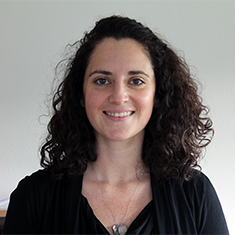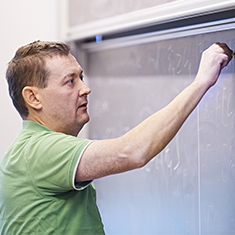Funding for mathematical experiments
Associate Professor Jesper Lund Pedersen and postdoc Alexandra Muñoz have received funding from the Villum Foundation to think outside the box. Their projects could lead to radical breakthroughs within mathematics. If they succeed.
"The VILLUM Experiment" is a totally new way to distribute research funding. The applicant's CV or networks will not be taken into account. All applications will be treated anonymously by the reviewers.
Thus, VILLUM FONDEN's aim is to support very special research ideas that challenge the norm and have the potential to fundamentally change the way we access important topics. The reviewers are asked to identify the ideas they regard as being genuinely innovative. Maybe only one in ten projects will prove capable of yielding something unique.
The Foundation has just awarded DKK 71 million to 39 unorthodox and potentially ground-breaking experiments. These experiments span a wide range: Topics include everything from biology to quantum physics, conversion of CO2 to climate-friendly material, cars that change color, systems that recognize insects without having to capture them first.
17 of the 39 experiments will take place at the University of Copenhagen. Two of the researchers are from the Department of Mathematical Sciences.
Beyond the Genome

Alexandra Muños
Postdoc Alexandra Muñoz has received DKK 2 million for the project "Beyond the Genome: Re-theorizing the cellular system". Professor and Research Director Thomas Sinkjær from VILLUM Fonden presents Alexandra Muñoz's project as follows:
"The main hypothesis that the experiment is based on is a bold challenge to of the central doctrines in modern science - that an organism's cells are solely controlled by the genetic material DNA. Just as quantum mechanics can describe a different layer of a physical system, this experiment will attempt to uncover another layer in the regulation of cells that functions when the genome is defective.
It is a high-risk experiment that could yield fantastic results or nothing. If the hypothesis turns out to be correct, the experiment will revolutionise and redefine our understanding of cell biology and have potentially ground-breaking influence on our understanding of, among other things, cancer. But the hypothesis may prove to be incorrect. Even then, the development of the proposed mathematical model will offer a unique and valuable framework for the conceptualisation of the cells."
Nonlinear quickest detection problems

Jesper Lund Pedersen
Jesper Lund Pedersen, associate professor from the Section for Insurance and Economics, has received DKK 1.8 million for searching for mathematical solutions on an area, which today is considered to be out of reach. If successful, it could help to improve the performance of atomic clocks, control satellites, land planes and detect earthquakes.
The problems involved in quickest detections arise from the need/desire to detect changes in observed data as quickly as possible after they occur in real time. These problems date back to the 1960s in the context of radar detection. Today quickest real-time detection is of great importance in many applied settings in engineering and the natural sciences - and a wide variety of other fields such as medicine and finance.
Translated into mathematical terms from modern probability theory, Jesper describes the project as follows:
We are observing a stochastic process with given probability characteristics which become altered at some unknown time which is not directly observable. The problem is to detect the time of change as accurately as possible using only the observations of the stochastic process itself.
Since exact detection is impossible, this ‘accurately’ means not beeing ‘too early’ (false alarm) nor ‘too late’ (detection delay).
The classic and modern theory of quickest detection was only developed for linear formulations of the problem, in the sense that ‘too early’ is expressed as the mean value related to a false alarm and ‘too late’ is expressed as the mean value related to detection delay. Within this framework the problems are Markovian so that one can use the theory of Markov processes and exploit their connections to linear differential equations when solving the problem.
The research will open up a novel way of looking at quickest detection where the central aim is to formulate and solve nonlinear quickest detection problems. In this context, a nonlinear formulation is obtained through nonlinear functions (e.g. variance) of the mean value related to a false alarm and the mean value related to detection delay.
- This should lead to faster and more efficient quickest detection. The idea is fundamentally new and the approach creates unconventional scientific challenges that have never been met in quickest detection before, explains Jesper.
The VILLUM Experiment
- Support for the bold research idea that would have difficulty fitting into the conventional peer-review funding system.
- Created for the very special research projects that challenge the norm and have the potential to fundamentally alter the way we approach important topics.
- The reviewers are asked to emphasize the ideas they regard as being genuinely innovative. Perhaps only one in ten projects will prove capable of yielding something unique.
- Each of the reviewers has the opportunity to appoint one application with a decisive vote. If this happens, there must be quite significant arguments from the foundation’s board of directors to reject the project.
- The amount granted is DKK 1-2 million, which is to cover a research period of 1-2 years.
- The program is open to all researchers regardless of nationality and can be applied for by active researchers regardless of any age.
Read more about the VILLUM Experiment
